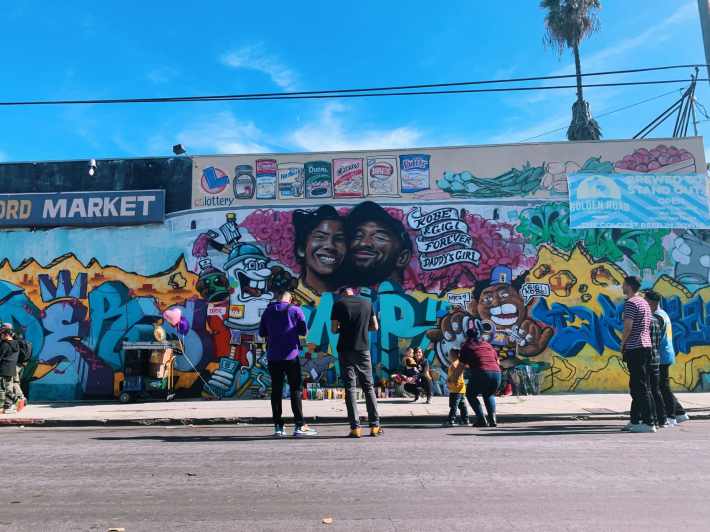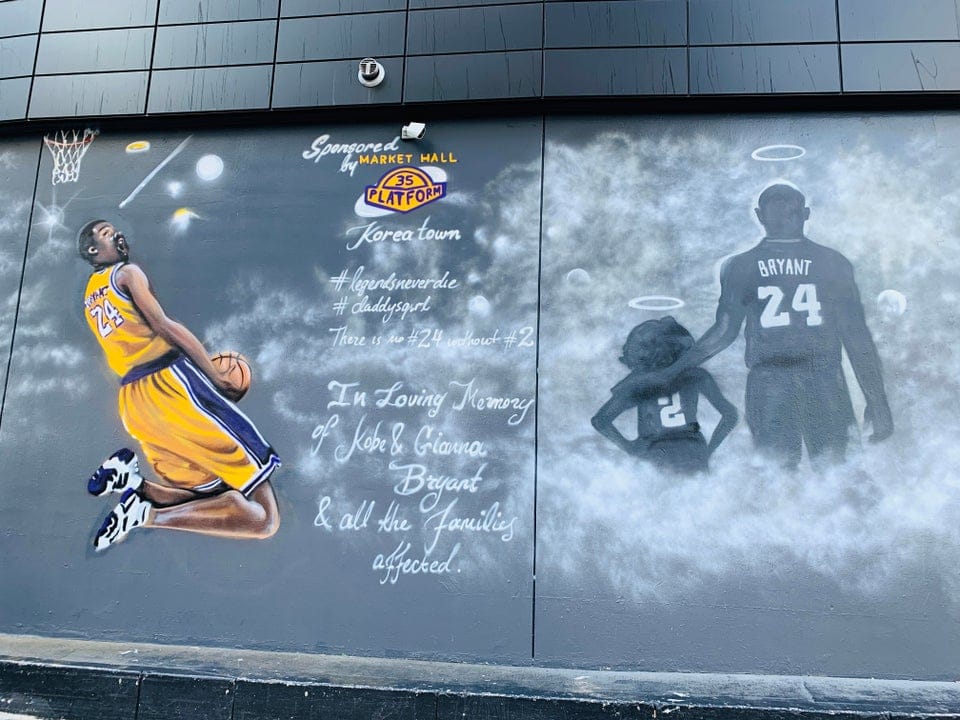[dropcap size=big]I[/dropcap] used to tell my friends that Korean moms love Kobe Bryant because he was a workaholic.
My own mother and I are currently in the process of remembering how we preserved Kobe. In the process of looking for all the front page clippings of him we snipped out of the Korea Times, I realized just how significant Kobe’s impact was to the Korean community in Los Angeles in one of the most segregated eras in the city.
1996, the year Kobe made his first career point from the free-throw line for the Lakers, was a pivotal time for L.A.’s Korean population. We were all still recalibrating from Sa-I-Gu (the Riots) that took place on April 29, 1992.
At the time, many older Koreans were feeling antagonized and confused by the media’s narrative that pit them against Black Angelenos. Much of the Korean papers sensationalized what happened after the verdict of the Rodney King trial, callously profiling the Black community as a retaliatory one. Meanwhile, American papers were not covering the shock and grief of an Asian immigrant community that was left to find their own safety when law enforcement would not arrive with aid.
Very few reporters were covering how Los Angeles had set up newcomers and minority groups to be second-class citizens in the years leading up to the riots. Confused and hurt by the uprising, my parents packed up and moved us away from Koreatown.
But then, Kobe introduced to them a different story.
Welcoming Kobe to Los Angeles in the mid-90s felt triumphant but it was also a way to circumvent the much-needed conversations around racial relations. Nowadays I look at 1992 and recognize how the Korean Angeleno community has a lot of unlearning and understanding to do of L.A.’s other disenfranchised groups. Still, as I remain a daughter of immigrants, I’ve been roaming in my compassion for my mother who once trudged through the noise of media pitting Koreans against Black or Hispanic communities. I imagine it must have felt lonely.

For several years, Los Angeles was lethargic and brittle from being so segregated until a young and hungry Kobe bolted into the city to reinvigorate the Lakers. His arrival felt like a new way to frame our experience here. For example, my mom doesn't like to talk about life before and after Sa-I-Gu, but she’ll openly talk about how much she loves watching basketball with her daughter.
I credit my mom and Mamba both for my work ethic, the good and the bad.
In 2013, the Lakers became the first NBA team to broadcast their games in Korean. This was a move that recognized the 350,000 Korean-Americans in the greater Los Angeles county with American-born sons and daughters who ate dinner with the game roaring from the living room or snuck peeks at the score on their phones at church.
After Time Warner Cable bought regional TV rights to Lakers games, the company hired Korean-American color commentators and play-by-play announcers for the broadcasts, one of whom was Lee. By this time, my mom was watching games on her own. She was repeating Kobe stats that even I didn’t retain. Her growing fascination with the Lakers helped her rebuild trust in a city that she once feared.
The ‘Mamba Mentality’ and the Korean Work Ethic
I credit my mom and Mamba both for my work ethic, the good and the bad.
For the better half of my 20s, I’d been correcting for all the ways I heedlessly let public figures shape me after realizing the impracticality of modeling my desires after another’s excellence that I will probably never meet. This growth has felt so incongruent with my lurching grief over Kobe’s passing. When it’s the athlete who inspired L.A. so singularly for some of its most pivotal years, I hadn’t reckoned with all that yet. Even though I’ve been coming into my own, Kobe was everything to me for almost my entire lifetime.
Then there’s my mom. She moved to Los Angeles in 1972 with dreams of working in fashion. She entered the textile industry, spinning fabric and weaving cloth at her different posts in the Fashion District until she moved to Koreatown with my dad in 1991. She used to restyle my dresses and jeans with cuts and stitching that she learned on the job. When we shopped together, she pointed out the dos and don’ts of synthetic materials that I can now recite in my sleep. She gained her incredibly niche knowledge by committing to a craft that she enjoyed every single day.
This is the most we had ever talked about our bodies after death. This was the first time I witnessed how she grieved.
Kobe’s love of work was universally understood and thus accessible to my Korean-speaking mother. He played in a way where she knew what he was feeling if the English commentary was too fast to follow. She loved his “made for TV” showmanship, like his scornful laughter from the bench or his frigid staredowns with players at the baseline. She could grasp for herself the breathless hang time on his fadeaway shots or his diametrically opposite moves: look for open shots like a bully then fly with the grace of a ‘90s Flutterbye Fairy.
The comedy of having a Korean mom who could fully comprehend this dagger of a madman on American television is that she would then wish all of that for me. Though she didn’t understand them, she would sit through his postgame interviews with me because the madman probably had great truths to impart. Our love for Kobe became so intertwined that I don’t remember who decided first that I was going to play basketball.
After Kobe’s second season, I joined a YMCA league. As I befriended girls who lived in Carson, Harbor City, and Lawndale, my mom would drive me to their houses on weekends to shoot around in their driveways. She liked that I was practicing hard and meeting girls of other ethnic backgrounds in L.A., a city that had challenged her at times. Maybe seeing her daughter thrive, despite what she had experienced herself, was a silver lining that wounds can heal.
Kobe’s death and the difficulty of talking about life after death in a Korean household
Several hours after I called my mom about Kobe’s passing, she texted me in Korean to pray that he rests easy because it must have been so hard for him with all the time and effort he spent on becoming a basketball great. Her religious wishes of his salvation were imbued with a candor that I rarely see in her. This is the most we had ever talked about our bodies after death. This was the first time I witnessed how she grieved.
I am at peace with all the ways my mom vaunted Kobe to encourage my own growth, but I am struck by how openly she and I are talking about sadness. This is the most we’ve ever talked about the life and death of things. Even after she lost her parents while raising a family alone in L.A., we did not memorialize them out loud. We also do not speak at length about Sa-I-Gu, which altered my mom’s life in unspeakable ways. I attribute this hesitance to talk about loss and tragedy with the immigrant parent’s resolve to look ahead and work towards stability.
His life and death transcended language barriers between immigrant parents and first- and second-generation children, something that challenges a lot of us Angelenos on any other day.
Kobe’s legacy began when the city looked to the stars for a supernova distraction. It indeed helped a lot of Korean-Americans reset and find joy in living in Los Angeles again. We all wanted to see and be like Kobe, which had us driving into Downtown again or discovering new neighborhoods because their daughters were making new friends after basketball practices.
My mom, a longtime Korean Angeleno, talks openly about how Kobe’s passing affects her. She nurses her grief in relation to her identity in the city. Her sadness is not forgotten or untold the way she felt it was in ‘92, nor is it felt any less because of her background. I am comforted by how much we all want our heartache to be seen and heard.
I imagine there are many other Koreans who are grieving in similar ways because they valued the same qualities in Kobe, or they got closer to their families as a result. His life and death transcended language barriers between immigrant parents and first- and second-generation children, something that challenges a lot of us Angelenos on any other day.
Truly, none of us are enduring this one alone.







